Knitting any fabric on the machine becomes easier if one thinks of black squares as knit stitches (selected needles on Brother), white squares as in this instance as either slipped or at times tucked stitches (non selected needles). Each number on the grids below represents 2 consecutive rows of knitting. The design may be elongated in the drawing of the final repeat itself prior to punching holes, marking mylar or pixels, or elongated in the built-in setting for the KM used, whether electronic or punchcard. Color changes are required every 2 rows.
The grids:
The patterns may be created by drawing shapes on the dotted grids, or “erasing” squares on the lined grids if more extended lines are desired. Some of the “rules” for mosaics were discussed in my previous post on the subject last October. A few more to consider in drawing your own:
color 1 is represented in row 1 and all odd-numbered rows
color 2 is represented by row 2 and all even-numbered rows
long horizontal lines in mazes usually occur on odd-numbered rows
even-numbered rows usually have no more than 2 black squares marked side by side
on odd-numbered rows, white squares slip
on even-numbered rows black squares slip
odd-numbered rows are knitted in the main color (black squares)
even rows are knitted in contrast color (white squares)
I think of row one/ odd rows as needing to knit black squares, row 2 and even rows having to knit white squares rather than marking in the traditional manner for slipped stitches on each row
a quickly drawn motif
checking out the motif in repeat  marking the knit stitches in odd rows
marking the knit stitches in odd rows 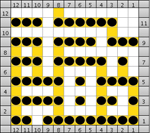 marking the knit stitches in even rows
marking the knit stitches in even rows 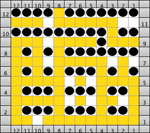 markings for all knit stitches
markings for all knit stitches
the red squares show the alternative markings for electronic KMs with color reverse Shared in an earlier post: using point grids,
Shared in an earlier post: using point grids, 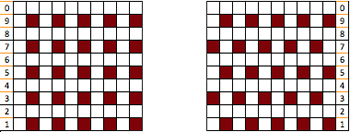 the pattern may be drawn over them;
the pattern may be drawn over them; 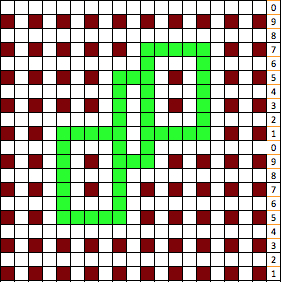 staggered units may require some cleanup and “erasing”, as represented by pink squares
staggered units may require some cleanup and “erasing”, as represented by pink squares 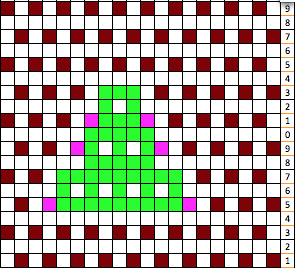 when the shape is what one desires, a color separation follows as for the design at beginning of the post
when the shape is what one desires, a color separation follows as for the design at beginning of the post
In knitting the pattern, the selection row is made in a non-patterning row toward the color changer. Unless each row is marked twice, the motif as above must be elongated X2
Test swatches for the resulting fabric, knit and purl side are shown respectively; note the lack of visibility of pattern where there is low contrast between the 2 colors used and the short floats on the reverse. Slip setting is used, though in row 11 the 2 side by side non-knitting squares may not pose a problem in knitting using tuck setting.
There is an online generator for patterns in this family by Laura Kogler. The image below shows one such generated pattern, in turn, saved and gridded in photoshop
Below are images processing the above design “by the rules”, based on red squares in the generated design. Figure 1 is the isolated repeat, figure 2 shows the stitches to be knit in color 1, figure 3 the stitches to be knit in color 2, in figure 4 the black dots represent punched holes, the red squares the areas that may be marked if the KM is capable of color reverse, the length must be doubled here as well, with the color changed every 2 rows, selection row toward the color changer.  The resulting fabric using slip setting, rows 4 and 5 make motif problematic for tuck setting
The resulting fabric using slip setting, rows 4 and 5 make motif problematic for tuck setting 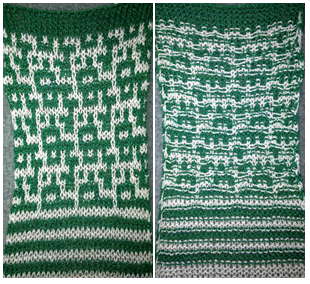 Working with the white squares in the generated design, now knitting the white on odd rows, the red on even: the grid on left shows the isolated repeat. In the grid on the right, the black dots equal the punched holes in the card, the white squares the mylar markings for use with color reverse. This motif would work in tuck <-> as well
Working with the white squares in the generated design, now knitting the white on odd rows, the red on even: the grid on left shows the isolated repeat. In the grid on the right, the black dots equal the punched holes in the card, the white squares the mylar markings for use with color reverse. This motif would work in tuck <-> as well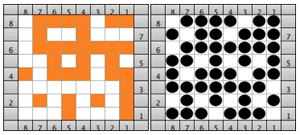 The 2 fabrics side by side, showing in this instance a slight difference in the overall repeat in the last swatch; in the left sample green is color one, in the right one white is color l
The 2 fabrics side by side, showing in this instance a slight difference in the overall repeat in the last swatch; in the left sample green is color one, in the right one white is color l 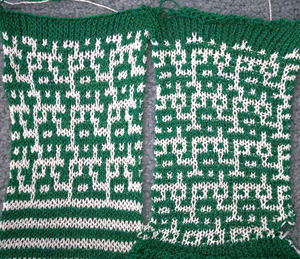 the same motif knit in the tuck setting is wider, both sides are shown below
the same motif knit in the tuck setting is wider, both sides are shown below  If the yarn used is capable of being blocked fairly flat, because of the short floats, finished items in these fabrics may not need to be folded over or lined as traditional FI items often do.
If the yarn used is capable of being blocked fairly flat, because of the short floats, finished items in these fabrics may not need to be folded over or lined as traditional FI items often do.
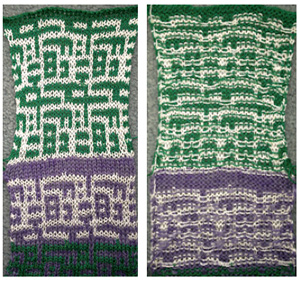
Good post. Happy drawing!